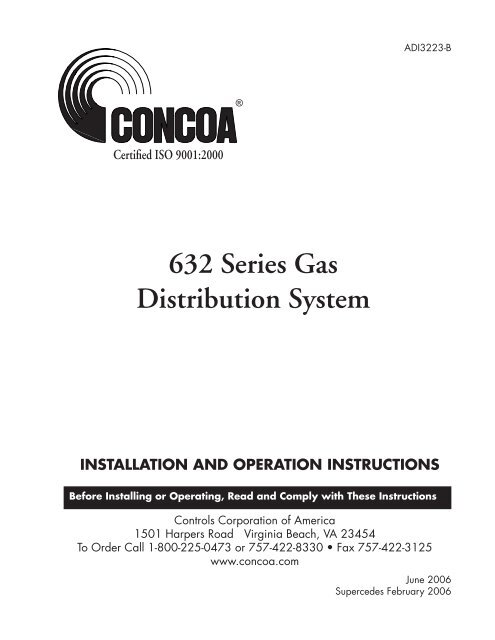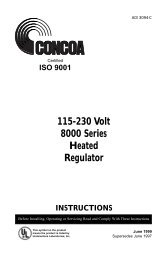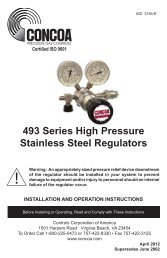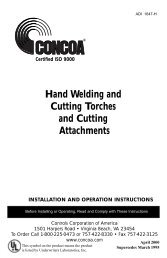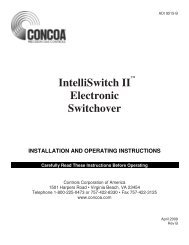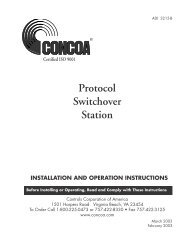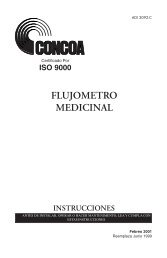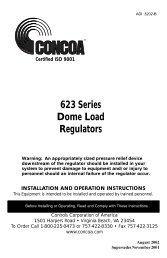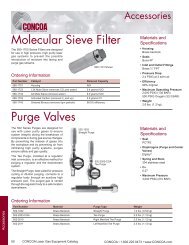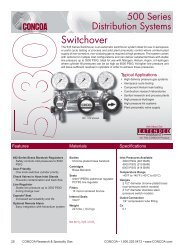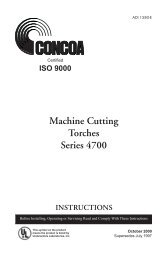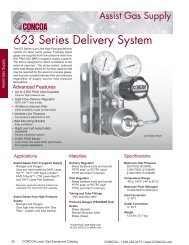632 Series Gas Distribution System INSTALLATION AND ... - Concoa
632 Series Gas Distribution System INSTALLATION AND ... - Concoa
632 Series Gas Distribution System INSTALLATION AND ... - Concoa
You also want an ePaper? Increase the reach of your titles
YUMPU automatically turns print PDFs into web optimized ePapers that Google loves.
to use an adapter. The recommended use of an adapter is for temporary use, for start-up and system checksonly. Adapters should never be used on a permanent basis.5. Comply with precautions listed in C.G.A. Pamphlet P-1, Safe Handling of Compressed <strong>Gas</strong>es inContainers.GENERAL SAFETY PRACTICESUnder no circumstances should liquid product be allowed into the hoses or manifold.Consult the cylinder distributor for the proper use of cylinders and for any restrictions on their use (such as flowrate and temperature requirements).Store cylinders with valve caps screwed on, and cylinders chained to a supporting wall or column.Handle cylinders carefully and only with valve caps screwed on. The cap will reduce the chance that the cylindervalve will break off if the cylinder is accidentally dropped or falls over. The cap also protects the cylinder valve fromdamage to screw threads, which could cause leaky connections.All manifolds used with flammable gases should be provided with approved flashback arrestors to stop any burninggas in the pipeline from getting back to the manifold or cylinders.No smoking should be permitted near oxygen, nitrous oxide, any other oxidizer, flammable gases, or flammablemixtures, or in areas where cylinders are stored.Where oxygen or nitrous oxide is used, the manifold and cylinders must be kept clean. No oil, grease, or combustiblesubstances should come in contact with oxygen or nitrous oxide storage or handling equipment. Such materials incontact with oxygen or nitrous oxide are readily ignitable and when ignited, will burn intensely.Never use an open flame when leak testing.Always open valves slowly when high-pressure gases are being used.Always be sure that a cylinder contains the correct gas before connecting it to any manifold.Always leak-test any manifold or distribution pipeline before using.Always be sure that the gas in a pipeline is the correct gas for the intended use.Always close all cylinder valves before disconnecting cylinders from a manifold.Always remove all empty cylinders from a manifold before connecting full cylinders.Always test cylinders to be sure the cylinders are full before connecting to a manifold.Always secure cylinders, whether in use or in reserve.All gas distribution piping systems must meet the appropriate industrial standards for the intended service and mustbe thoroughly cleaned before using. For the United States, some applicable safety rules and precautions are listedbelow:1. American National Standards Institute standard Z49.1, Safety in Welding and Cutting, American WeldingSociety, 2501 NW Seventh Street, Miami, Florida 33125--
2. N.F.P.A. Standard 51, Oxygen-Fuel <strong>Gas</strong> systems for Welding and Cutting, N.F.P.A., 470 Atlantic Avenue,Boston, Massachusetts 022103. N.F.P.A. Standard 51B, Cutting and Welding Processes (same address as #2).4. CONCOA publication ADE 872, Safety Precautions in Welding and Cutting.5. Local Ordinances6. O.S.H.A. Standard 29 CFR7. C.G.A. Pamphlet C-4, American National Standard Method of Marking Portable Compressed <strong>Gas</strong> Containersto Identify the Material Contained.8. C.G.A. Pamphlet G-4, Oxygen – Information on the properties, manufacture, transportation, storage,handling, and use of oxygen.9. C.G.A. Pamphlet G-4.1, Equipment Cleaned for oxygen service.10. C.G.A. Pamphlet G-4.4, Industrial Practices for <strong>Gas</strong> Oxygen Transmission and <strong>Distribution</strong> Piping<strong>System</strong>s.11. C.G.A. Pamphlet G-5, Hydrogen – Information on the properties, manufacture, transportation, storage,handling, and use of hydrogen.12. C.G.A. Pamphlet G-6, Carbon Dioxide – Information on the properties, manufacture, transportation,storage, handling, and use of carbon dioxide.13. C.G.A. Pamphlet G-6.1, Standard for Low Pressure Carbon Dioxide <strong>System</strong>s at Consumer Sites.14. C.G.A. Pamphlet P-1, Safe Handling of Compressed <strong>Gas</strong>es in Containers.15. C.G.A. Safety Bulletin SB-2, Oxygen Deficient Atmospheres.*C.G.A. pamphlets can be obtained from the Compressed <strong>Gas</strong> Association, 1235 Jefferson Davis Highway, Arlington,VA 22202-3239, (703) 979-0900. Publications: (703) 979-4341. Fax: (703) 979-0134.Keep all cylinders and manifolds away from any source of high temperature over 120°F (50°C) or possible fire hazards.High-pressure gas contained in a closed cylinder becomes increasingly dangerous when exposed to high temperaturebecause pressure increases and the strength of the cylinder decreases. Manifolds installed in open locations should beprotected from weather conditions. During winter, protect the manifold from ice and snow. In summer, shade themanifold and cylinders from continuous exposure to direct sunlight. Always leave access to the manifold for cylinderreplacement. Always secure cylinders, whether in use or in reserve.LOCATIONThe site chosen for the manifold installation shall be level, well ventilated, and at a safe distance from sources offlames, sparks, and excessive heat. The manifold should not be placed in an area that may subject the manifold todamage from passing trucks, cranes, or other heavy machines. Oxygen manifolds must not be installed under shafting,belting, or other places where oil can drip on them. Under no circumstances should liquid product be allowed intothe hoses or manifold. For other location guidelines, see NFPA Standard 50 and 51.<strong>INSTALLATION</strong>Installing the system:1. Be sure to consider all factors when selecting materials.2. Do not use oil or grease on fittings.3. Be sure that all fittings are secure and leak tight. PTFE tape should be used on pipe threads as illustrated inFigure1.4. Purge devices: These devices can be purchased as accessories. Purge devices are used to remove toxic, corrosive,or flammable gases from the customer’s system to a safe discharge area. This is particularly helpful when aninternal problem occurs (such as regulator malfunction).--
INSTALLING INLET <strong>AND</strong> OUTLET CONNECTIONSUse an open-end wrench, not a pipe wrench, to install accessories to the system. The NPT connections require theuse of PTFE tape on the threads to make a gas tight seal. On stainless steel connections, the PTFE tape helps preventthe connections from galling together when tightening or loosening. Follow these rules when using PTFE tape.Taping procedure:Figure 1 - Pictorial view of tape seal installationBefore applying PTFE tape, inspect the NPT threads and if necessary, clean the fitting to remove any dirt or threadsealant that remains on the threads. Start the PTFE tape on the second thread as shown above; make sure the tapedoes not overlap the end of the fitting. As the tape is wrapped in the direction of the thread spiral, pull tightly on theend of tape so that the tape conforms to the threads. Apply two overlapping layers of PTFE tape. Cut off the excesstape and press the end firmly into the threads.WALL MOUNTING<strong>632</strong> Installation with Single Hose1. Determine and mark the vertical center line for installation of the base <strong>632</strong> <strong>System</strong>.2. Measure from the floor 73" and make a mark on the line of center. Using a level, draw a horizontal line fromthe mark extending approximately 10 inches to the left and right of center. The height of 73” is recommended;SPIRIT LEVELCENTERLINEFigure 2 - Wall mount installation73" (1.85 m)FLOOR LINE--
the typical installation for high-pressure cylinders needs 66 inches between the floor and the “INLET” port.Leave enough space between the cylinder tops and the manifold.3. Place the upper edge of the panel on the horizontal line so that the 6700 <strong>Series</strong> delivery regulator is centeredwith the vertical line.Figure 34. As illustrated in Figure 3, the <strong>632</strong> is secured to a panel that has mounting holes located at each corner.5. Mark the location of the panel mounting holes.6. Using the appropriate hardware, anchor the switchover mounting bracket to the wall. Make sure the panelis level.7. Tape the ¼” M-NPT thread of the cylinder pigtail.8. Secure the street elbow with a wrench while threading the taped male NPT end of the pigtail.9. Repeat steps 7-8 for the opposite inlet of the switchover.10. Refer to “Connecting a Cylinder” for directions on connecting the pigtail to the cylinder.11. Refer to “Pressure Testing the <strong>System</strong>” to confirm that there are no leaks in the system.<strong>632</strong> Installation with Single Hose with Master ValveThis configuration does not include an inlet pressure gauge.1. Determine and mark the vertical line of center for installation of the <strong>632</strong> system.2. Measure from the floor 73” and make a mark on the line of center. Using a level, draw a horizontal linefrom the mark extending approximately 10 inches to the left and right of center as illustrated in Figure 2.The height of 73 inches is recommended; the typical installation for high-pressure cylinders needs 66 inchesbetween the floor and the “Inlet” port. Leave enough space between the cylinder tops and the manifold.3. Place the upper edge of the panel on the horizontal line so that the 6700 series delivery regulator is centeredwith the vertical line.4. As illustrated in Figure 3, the <strong>632</strong> is secured to a panel that has mounting holes located at each corner.5. Mark the location of the panel mounting holes.6. Using appropriate hardware, anchor the switchover mounting bracket to the wall. Make sure the panel islevel.7. Tape the ¼” M-NPT thread of the cylinder pigtail.8. Secure the street elbow located on the master valve with a wrench while threading the taped male NPT endof the pigtail as illustrated in Figure 4.9. Repeat steps 6 through 7 for the opposite inlet of the switchover.--
10. Refer to “Connecting a Cylinder” for directions on connecting the pigtail to the cylinder.11. Refer to “Pressure Testing the <strong>System</strong>” to confirm that there are no leaks in the system.<strong>632</strong> Installation with a 629 ManifoldFigure 41. Determine and mark the vertical line of center for installation of the <strong>632</strong> system.2. Measure from the floor 73” and make a mark on the line of center. Using a level, draw a horizontal linefrom the mark extending approximately 10 inches to the left and right of center as illustrated in Figure 2.The height of 73 inches is recommended; the typical installation for high-pressure cylinders needs 66 inchesbetween the floor and the “Inlet” port. Leave enough space between the cylinder tops and the manifold.3. Place the upper edge of the panel on the horizontal line so that the 6700 series delivery regulator is centeredwith the vertical line.4. As illustrated in Figure 3, the <strong>632</strong> is secured to a panel that has mounting holes located at each corner.5. Mark the location of the panel mounting holes.6. Tape the ½” M-NPT thread on the micro-manifold.7. Thread the male end of the micro-manifold into the switchover’s ½” F-NPT inlet.8. If the manifold capacity is five or more cylinders install the micro-manifold extension kit into the9. Secure the final micro-manifold with a wrench.--Figure 5
10. Repeat steps 5 through 9 for the opposite inlet of the switchover.11. Relocate the assembly back on the wall so that the <strong>632</strong> panel mounting holes line up. Mark each 629mounting bracket holes.12. Using appropriate hardware, anchor the assembly mounting panel and brackets to the wall.13. Make sure that all connections are tightened.14. Apply Teflon tape to the ¼” M-NPT end of each pigtail.15. Remove the desired number of ¼” F-NPT pipe plugs from the bottom of the micro-manifold block.16. Install the pigtail into the micro-manifold ¼” F-NPT port as illustrated in Figure 5.17. Repeat steps 13 through 16 for opposite manifold bank.18. Refer to “Connecting a Cylinder” for directions on connecting the pigtail to the cylinder.19. Refer to “Pressure Testing the <strong>System</strong>” to confirm that there are no leaks in the system.<strong>632</strong> Installation with 629 Manifold and Master Valve1. Determine and mark the vertical line of center for installation of the <strong>632</strong> system.2. Measure from the floor 73” and make a mark on the line of center. Using a level, draw a horizontal linefrom the mark extending approximately 10 inches to the left and right of center as illustrated in Figure 2.The height of 73 inches is recommended; the typical installation for high-pressure cylinders needs 66 inchesbetween the floor and the “Inlet” port. Leave enough space between the cylinder tops and the manifold.3. Place the upper edge of the panel on the horizontal line so that the 6700 series delivery regulator is centeredwith the vertical line.4. As illustrated in Figure 3, the <strong>632</strong> is secured to a panel that has mounting holes located at each corner.5. Mark the location of the panel mounting holes.6. Tape the ½” M-NPT thread on the micro-manifold.7. Thread the male end of the micro-manifold into right side master valve’s ½” F-NPT inlet.8. If the manifold capacity is five or more cylinders install the micro-manifold extension kit into the ½” F-NPTend of the previous micro-manifold.10. Secure the final micro-manifold with a wrench.11. Repeat steps 6 through 10 for the opposite inlet of the switchover.12. Relocate the assembly back on the wall so that the <strong>632</strong> panel mounting holes line up.13. Mark each 629 mounting bracket holes.14. Using appropriate hardware, anchor the assembly mounting panel and brackets to the wall.15. Make sure that all connections are tightened.16. Apply Teflon tape to the ¼” M-NPT end of each pigtail.17. Remove the desired number of ¼” F-NPT pipe plugs from the bottom of the micro-manifold block.18. Install the pigtail into the micro-manifold ¼” F-NPT port as illustrated in Figure 5.19. Repeat steps 13 through 16 for opposite manifold bank.20. Refer to “Connecting a Cylinder” for directions on connecting the pigtail to the cylinder.21. Refer to “Pressure Testing the <strong>System</strong>” to confirm that there are no leaks in the system.CONNECTING A CYLINDERWhile the <strong>632</strong> can function as a switchover with a liquid cylinder primary and high pressure reserve, it is not designedto provide optimal performance as obtained in the 600 series IntelliSwitch products. Additionally, maximum operatingflows will be lower under certain pressure conditions.The 629 series micro-manifolds included with the <strong>632</strong> should only be used with liquid cylinders if they are retrofittedwith burst disks for safety. Additionally, all flexible hoses used with liquid cylinders should be armor-cased toprevent failure.For further information about using liquid cylinders with the <strong>632</strong>, please contact CONCOA.--
Connecting High-Pressure CylindersRead the next section before installing cylinders. The <strong>632</strong> is designed to deliver gaseous phase from either liquidor high-pressure cylinders (4,500 Psi Max.). Never connect both liquid and high-pressure cylinders to the samemanifold.1. Before removing the cylinder cap, move the cylinder with a cylinder cart to the work site:a. Secure cylinder to the floor, wall, stand or bench with the appropriate chain or strap, to preventtoppling.b. Remove the cap if using a high-pressure cylinder. However, the large diameter ring located at the top ofa liquid cylinder protects the cylinder valves instead of a capc. Be sure the cylinder valve is tightly closed (clockwise)d. Remove the cylinder valve plug, if any.e. Inspect the cylinder valve and threads for damage or contamination.2. If replacing an empty cylinder,a. Close the manifold master valve (if equipped) and each header valve (if using the 628 manifold).b. Close the gas use valves on each cylinder on the depleted cylinder bank.c. Loosen the pigtail CGA connection to the cylinder’s gas use valve a quarter turn to depressurize.WARNING: The operator should secure the pigtail with one hand until exhausting of gas hassubsided.d. Finish removing the CGA connection from the gas use valve.e. Repeat process for each additional liquid cylinder to be used on the manifold.f. Replace the empty cylinders.3. Secure the pigtail cylinder connection to the high-pressure cylinder valve in the following manner:a. Thread the nut into the cylinder valve CGA connection. Do not cross thread or force. If it does not fit,the connection may be wrong for the type of gas being used.b. Left-hand threads are used on flammable type cylinder connections. The notch in the middle of the hexnut can identify them.c. Teflon gaskets or washers are used for some cylinder connections such as carbon dioxide CGA 320. Besure the gasket is in good shape. Do not over-tighten to avoid deforming the gasket which may createa leak or failure.WARNING: Never use oil or grease on regulator or cylinder fittings, as it may contaminate pure gasesor create a fire hazard.4. Open each cylinder gas use valve after all new cylinders have been properly connected and secured.5. Check all joints for leaks using oxygen compatible leak detection solution.6. If a leak is detected, depressurize the system and fix leaking connection. Never attempt to fix a leak underpressure.7. Once all connections are secure and leak free continue to the next step.8. Open each cylinder gas use valve after all new cylinders have been properly connected and secured.9. Open the manifold master valve (if equipped).10. The <strong>632</strong> is ready for use.Connecting Liquid CylindersRead the next section before installing cylinders. The <strong>632</strong> is not designed for liquid cylinders to be used on both theleft and right bank inlets at the same time. The <strong>632</strong> will work optimally with the priority arrow pointing left towardsthe left bank liquid cylinder with high-pressure cylinders on the right. It is recommended to use a 629-2xxx seriesvent manifold when supplying multiple liquid cans on one bank. The vent manifold is designed to provide headspaceequalization via a common connection for multiple liquid cylinder vent use valves.--
1) Before removing the cylinder cap, move the cylinder with a cylinder cart to the work site:a) Secure cylinder to the floor, wall, stand or bench with the appropriate chain or strap to preventtoppling.b) The large diameter ring located at the top of the liquid cylinder protects the piping and valves.c) Be sure the cylinder valve is tightly closed. (Clockwise)d) Remove the cylinder valve plug, if any.2) If replacing an empty cylinder,a) Close the manifold master valve (if equipped) and each header valve (if using the 628 manifold).b) Close both the gas use and vent use valves on each liquid cylinder on the depleted cylinder bank.c) Loosen the pigtail flare connection to the cylinder’s vent use valve a quarter turn to depressurize thevent manifold. A restrictive flow orifice has been installed between the manifold block and the pigtailto prevent whipping during a cylinder exchange.WARNING: The operator should secure the pigtail with one hand until exhausting of gas hassubsided.d) Finish removing the flare connection.e) Repeat process for each additional liquid cylinder to be used on the manifold.f) Loosen the pigtail CGA connection to the cylinder’s gas use valve a quarter turn to depressurize.WARNING: The operator should secure the pigtail with one hand until exhausting of gas hassubsided.g) Finish removing the CGA connection from the gas use valve.h) Repeat process for each additional liquid cylinder to be used on the manifold.i) Replace the empty cylinders.3) Secure the pigtail cylinder connection to the liquid cylinder vent use valve in the following manner:a) Thread the pigtail flare nut onto the vent use valve CGA 295 or 440-flare connection of each cylinder.Do not cross thread or force. If it does not fit, the connection may be wrong for the type of gas beingused.WARNING: Pay extra caution when reconnecting the pigtail to the new liquid cylinder vent usevalve. Both the vent and liquid use valves incorporate the same connection.b) Open each vent use valve (counter clockwise).4) Thread the pigtail CGA nut into the gas use valve connection of each cylinder. Do not cross thread or force.If it does not fit, the connection may be wrong for the type of gas being used. If the gas supply source is aliquid cylinder identify the gas use valve before making a connection.a) Open each gas use valve (counter clockwise).WARNING: The carbon dioxide liquid cylinder incorporates a CGA 320 connection on both thegas use and liquid fill valves. Premature pigtail failure may occur if a polymer lined pigtail is exposedto cryogenic liquid temperature.5) Open the liquid cylinder pressure building (PB) valve and adjust the PB regulator at least 50 psi abovethe pressure control device line pressure. A greater pressure differential may be required for higher flowrequirements.6) Check all joints for leaks using oxygen compatible leak detection solution.7) If a leak is detected, depressurize the system and fix leaking connection. Never attempt to fix a leak underpressure.8) Once all connections are secure and leak free continue to the next step.9) Open each cylinder gas and vent use valves after all new liquid cylinders have been properly connected andsecured.10) Open the manifold master valve (if equipped) and each header valve (if using the 628 manifold).11) The <strong>632</strong> manifold is ready for use.-10-
Pressure Testing the <strong>632</strong> ManifoldBefore system startup, it is recommended that all systems be pressure tested, leak tested, and purged with a clean,dry inert gas like helium or argon.1. Wear safety glasses and gloves.2. Connect last pigtail on the manifold to a test cylinder regulated to 50 PSI as illustrated in Figure 6. Do notopen the cylinder valves yet.3. Make sure all pigtails have been properly secured to the <strong>632</strong> manifold.4. Isolate the outlet of the pressure control device (Regulator or Switchover) from the piping leading to thepoint of use. This will allow you to confirm that the manifold and pressure control device is leak free. It isnot uncommon for there to be a small leak in the pipe line or point of use.Figure 65. When first pressurizing, do not stand in front or in contact with regulator or switchover system.WARNING: If the attached regulator is preset, or a switchover is without a line regulator, gas will escapefrom the delivery side of the pressure control device.6. Turn the adjusting screw or knob of the test regulator counter clockwise until it disengages the adjustingspring.7. Slowly, open the test cylinder valve.8. Next, adjust the test regulator to 50 PSI.9. Wait 5-10 seconds for the system pressure to equalize.10. Close the test cylinder valve.11. Inspect all connections for leaks and fix any leaks. A leak detection solution may be applied to the connections(if compatible with the application) which indicates leaks by bubbling. To further check for leaks or if aleak detection solution can not be used, keep test cylinder valve closed for a period of time (24 hours) andobserve the test regulator’s low pressure gauge for a drop in pressure.12. If a drop in pressure is observed, recheck all connections.13. Depressurize the system and fix leaking connection. Never attempt to fix a leak under pressure.14. Once all connections are secure and leak free continue to the next step.15. Now set the outlet pressure of the pressure control device and open any isolation valve to allow the pipe lineto pressurize.16. Repeat steps 5 through 14.17. When all leaks are fixed, close the test cylinder valve. Bleed system pressure to zero.18. Repeat steps 1 through 17 with test regulator set at 500 PSI.19. Disconnect the test cylinder and regulator.20. Connect service gas cylinders to the manifold by following the section titled “Connecting a Cylinder”-11-
OPERATIONHigh-Pressure Primary with High-Pressure Reserve1. At start up connect full cylinders to the left and right cylinder bank by following the appropriate sectiontitled “Connecting a Cylinder”.2. Rotate the priority valve to the high-pressure cylinder bank that you establish as primary.3. Set the desired line pressure as required by the application. The <strong>632</strong> will automatically withdraw gas fromthe primary cylinder bank.4. The <strong>632</strong> 50-PSI and 120-PSI models will automatically switch over to the left cylinder bank at 215 PSIwhen the priority arrow is pointing to the right bank. The <strong>632</strong> will switch over to the right bank at 180 PSIwith the arrow to the left. The 15 PSI model will switch at 80 PSI and 60 PSI respectively.5. Bank depletion is conveyed by either a remote alarm or the inlet pressure gauge value has reached the respectiveswitching pressure listed in step 4.6. Isolate the manifold side that has depleted by closing it’s master valve (if equipped) as illustrated in Figure7A.Figure 7A7. Rotate the <strong>632</strong> priority valve away from the depleted cylinder bank if both banks are high-pressure cylindersas illustrated in Figure 7B.Figure 7B-12-
8. Replace the empty cylinders by following the section titled “Connecting High-Pressure Cylinders”.Liquid Cylinder Primary with High-Pressure Reserve1. The <strong>632</strong> will work optimally as a liquid primary with a high-pressure reserve system by rotating the priorityarrow towards the left bank while locating high-pressure cylinders on the right.2. At start up connect full liquid cylinders on the left bank and high-pressure cylinders on the right bank byfollowing the appropriate section titled “Connecting a Cylinder”.3. Set the desired line pressure as required by the application. The <strong>632</strong> will automatically withdrawal gas fromthe primary cylinder bank.4. The <strong>632</strong> 50-psi and 120-psi models will automatically switch over to the right cylinder bank at 180 psi withthe arrow to the left.5. Bank depletion is conveyed by either a remote alarm or the inlet pressure gauge value has reached the respectiveswitching pressure listed in step 4.6. Isolate the manifold side that has depleted by closing it’s master valve (if equipped) as illustrated in Figure 8.Do not rotate priority valve if the <strong>632</strong> is being operated with a left bank primary liquid source and a rightbank high-pressure reserve.7. Replace the empty cylinders by following the section titled “Connecting High-Pressure Cylinders”.Figure 8-13-
MAINTENANCEAt regular intervals, the <strong>632</strong> <strong>Series</strong> <strong>Gas</strong> <strong>Distribution</strong> <strong>System</strong> should be checked for leaks and proper function (seeTroubleshooting). The pigtail check valve should also be checked for leaks when a depleted cylinder is removed.Note: the system inlet and pigtail should be pressurized when checking for leaks. Any leaks in the system should becorrected immediately.TROUBLESHOOTINGTypical symptoms listed below indicate MicroManifold system malfunctions needing repair. Replace immediatelywith a clean, repaired and tested, or new system.1. <strong>Gas</strong> leakage from any joint.2. Manifold master valve when closed does not cut off the gas supply to the regulator.3. The system makes a noise or hums.SERVICEA unit that is not function properly should not be used and should be returned to CONCOA for service. AReturn Material Authorization (RMA) number must be issued for any product returned to CONCOA for service.Please contact a Customer Service Representative at 1-800-225-0473 to receive this number. You will be asked toprovide:1. Model Number2. <strong>Gas</strong> Service3. Inlet pressure and type of gas supply4. Outlet pressure5. Approximate gas usageWhen shipping product back to CONCOA for repair the following steps should be followed:1. Package the product sufficiently to prevent damage. If possible return product in its original packing.2. Include RMA number on the outside of the carton.3. Ship prepaid.4. Include a written description of the problem you encountered with the product inside the package.5. Include a statement of the gas service the product was used in.6. Purge all equipment before shipping to protect the transporter and service personnel. Purging is especiallyimportant if the equipment has been in flammable gas service.Return trip transportation charges are to be paid by the Buyer. In all cases where the warranty has expired, repairswill be made at current list price for the replacement part(s), plus a reasonable labor charge.-14-
Warranty InformationThis equipment is sold by Controls Corporation of America under the warranties set forth in thefollowing paragraphs. Such warranties are extended only with respect to the purchase of this equipment directlyfrom Controls Corporation of America or its Authorized Distributors as new merchandise and areextended to the first Buyer thereof other than for the purpose of resale.For a period of one (1) year from the date of original delivery (90 days in corrosive service) to Buyer or to Buyer’sorder, this equipment is warrantied to be free from functional defects in materials and workmanship and to conformto the description of this equipment contained in this manual and any accompanying labels and/or inserts, providedthat the same is properly operated under conditions of normal use and that regular periodic maintenance and serviceis performed or replacements made in accordance with the instructions provided. The foregoing warranties shallnot apply if the equipment has been repaired: other than by Controls Corporation of America or adesignated service facility or in accordance with written instructions provided by Controls Corporation ofAmerica, or altered by anyone other than Controls Corporation of America, or if the equipmenthas been subject to abuse, misuse, negligence or accident.Controls Corporation of America’s sole and exclusive obligation and Buyer’s sole and exclusive remedyunder the above warranties is limited to repairing or replacing, free of charge, at Controls Corporation ofAmerica’s option, the equipment or part, which is reported to its Authorized Distributor from whom purchased,and which if so advised, is returned with a statement of the observed deficiency, and proof of purchase of equipmentor part not later than seven (7) days after the expiration date of the applicable warranty, to the nearest designatedservice facility during normal business hours, transportation charges prepaid, and which upon examination, is foundnot to comply with the above warranties. Return trip transportation charges for the equipment or part shall be paidby Buyer.Controls Corporation of America shall not be otherwise liable for any damagesincluding but not limited to: incidental damages, consequential damages, orspecial damages, whether such damages result from negligence, breach ofwarranty or otherwise.There are no express or implied warranties which extend beyond the warrantieshereinabove set forth. Controls Corporation of America makes no warrantyof merchantability or fitness for a particular purpose with respect to theequipment or parts thereof.-15-
ADI3223-BCertified ISO 9001:2000Controls Corporation of America1501 Harpers Road Virginia Beach, VA 23454To Order Call 1-800-225-0473 or 757-422-8330 • Fax 757-422-3125www.concoa.com


